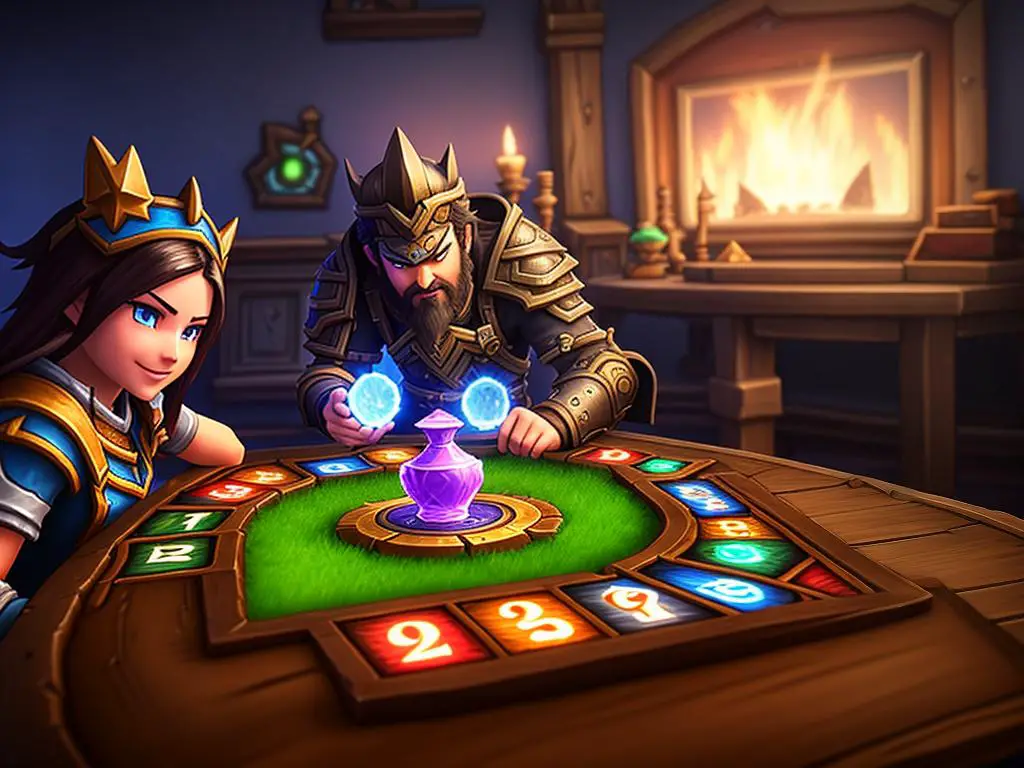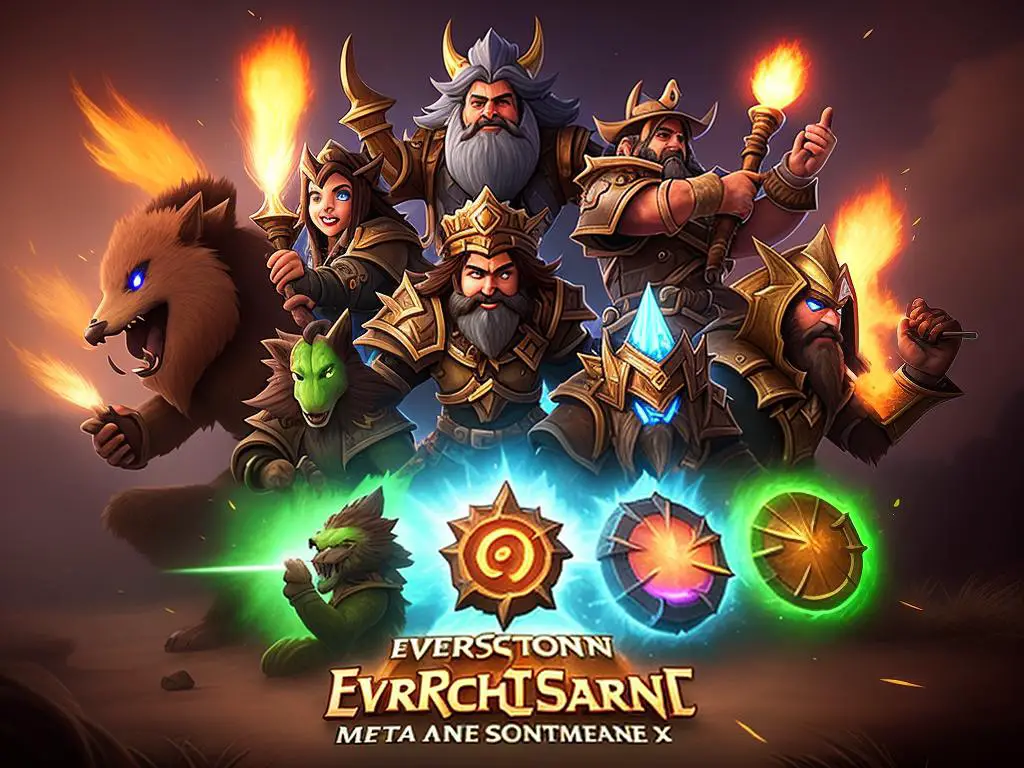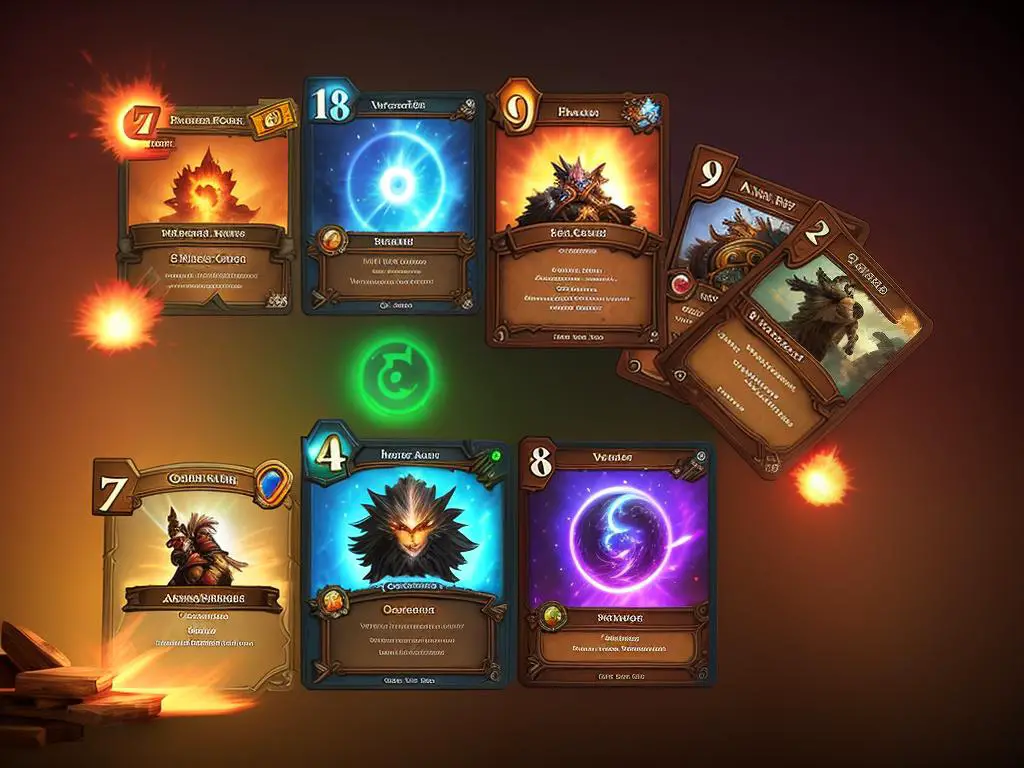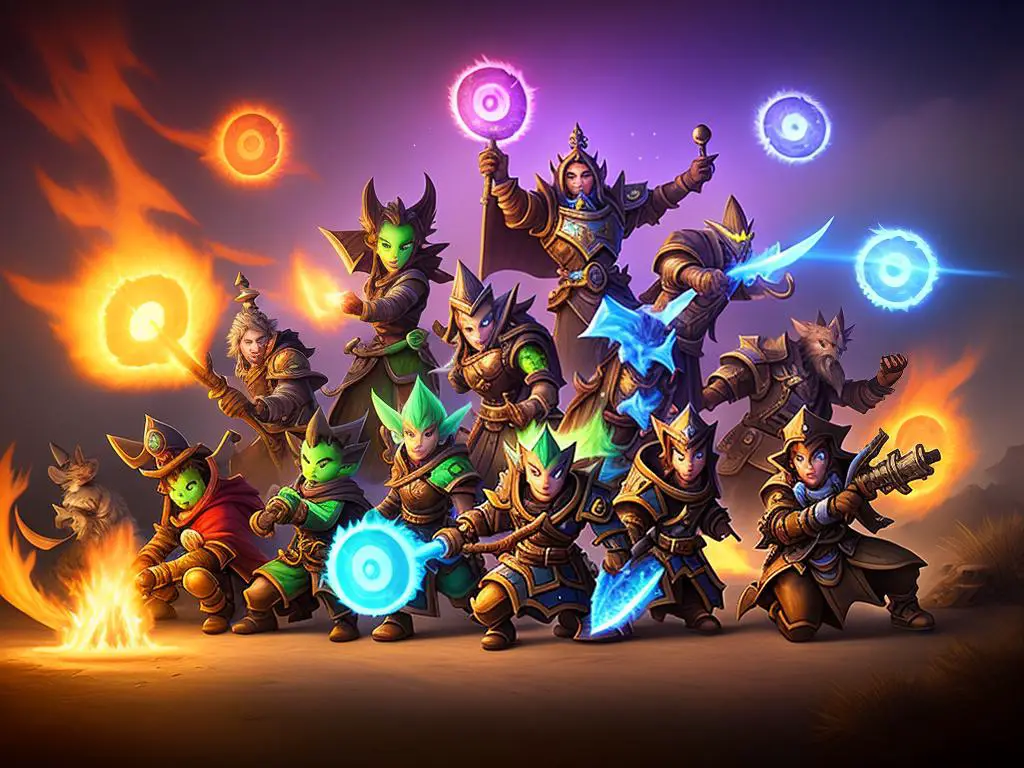Immersing oneself in a complex and ever-evolving strategy game, such as Hearthstone, is not just about the thrill of competition. It’s also about delving deep into its universe, becoming familiar with its unique dynamics, and fully comprehending its meta game. In this exploration of Hearthstone’s pulsating core, we peel back the layers of the uniquely fascinating component – the meta game. Through this journey, we’ll traverse its history, breaking down the factors that have influenced its evolution while simultaneously unpacking its current state, and laying out effective strategies to adapt and respond to the incessant shifts that define its very essence.
Understanding Hearthstone and Meta Game
Understanding Hearthstone: A Digital Card Game Phenomenon
Hearthstone is a turn-based digital card game developed by Blizzard Entertainment. Based on the lore of the Warcraft series, it leverages a rich universe of characters, spells and abilities. The game involves two players, each possessing a deck of 30 cards and a hero with a unique power. The objective of the game is to reduce the opponent’s health points to zero.
Meta-game in Hearthstone: A Dynamic System
In the context of Hearthstone, Meta or Meta-game refers to the game’s current state of strategy, which involves what decks are popular or powerful, what classes are dominant, and what cards are commonly used. It’s a kind of game within a game. It reflects not only the individual game mechanics and balance but also the prevailing trends followed by the player community.
Meta is not immutable; instead, it is dynamic and continually evolves. The updates and expansions introduced by the developers, the discovery of new, effective strategies by players, or even major esports tournaments can all dramatically change the meta.
Relevance of Meta in Hearthstone
Understanding and keeping up with the current meta is essential for anyone seeking success in Hearthstone, whether they are a casual player, a competitive player, or a game enthusiast.
For a casual player, understanding the meta helps to build efficient decks and choose suitable heroes for different situations. Competitive players, knowledge of the meta is crucial for success in tournaments and high-rank ladder play. For enthusiasts, analyzing the meta’s evolution provides a deeper appreciation for the game’s strategic depth and complex balancing.
Navigating the Hearthstone Meta-Evolution
A variety of online tools and resources can help to stay updated with the evolving meta. Websites like HSReplay, Vicious Syndicate, and Hearthstone Top Decks offer up-to-date meta reports based on millions of games. These reports break down the game into different ranks and provide statistics on the most powerful, popular decks and cards.
Twitch streams and YouTube content of top-level players and influencers can provide insights into cutting-edge strategies and underutilized cards that could become meta game changers.
Additionally, participating in online forums and communities such as Reddit’s r/Hearthstone offers an excellent opportunity to discuss the meta with other players, ask questions, and share insights.
Familiarizing with Hearthstone: Essential Terminology and Principles
To navigate the extensive world of Hearthstone, it is pivotal to first familiarize oneself with the game terminology frequently used to discuss the evolving meta:
- Deck: This term refers to a collection of 30 cards a player utilizes during a match.
- Class: This signifies the specific game character chosen by a player. Each class provides a unique set of cards and a distinct ability.
- Winrate: This is the percentage representing the number of games won by a particular deck or class over a decent number of games.
- Meta Deck: A Meta Deck is one that is considered powerful, and is thus used frequently in the ongoing meta.
- Counter Deck: This term refers to a deck that is specifically constructed to have a high winrate against a trending Meta Deck.
- Tech Card: A Tech Card is mainly included in a deck to help enhance a specific matchup, often against a well-liked Meta Deck.
Consequently, getting to grips with Hearthstone and its nuanced meta-game is an intriguing journey filled with complexity. A solid understanding of the game’s mechanics allows players to proficiently navigate and conquer the intricate world of Hearthstone.

Historical Overview of Meta Evolution in Hearthstone
The Genesis of Hearthstone and Basic Deck Strategies
During its inception in 2014, the Hearthstone meta was largely shaped by rudimentary deck strategies and the limited availability of formidable cards. Two dominant decks during this era were the Midrange Hunter, rooted in the “Buzzard-Unleash” combo, and the Handlock, a comparatively slow-paced deck based on the Warlock’s Life Tap ability and imposing minions. Concurrently, the Miracle Rogue began making significant strides, leveraging powerful draw mechanics centered around the “Gadgetzan Auctioneer” card.
Alteration with Naxxramas
The first major meta shift occurred after the introduction of the “Curse of Naxxramas” expansion. With the addition of powerful Deathrattle cards, Zoo Warlock and Undertaker Hunter became the dominant decks in the meta. Zoo Warlock leveraged the Warlock hero power to consistently generate resources while Undertaker Hunter took advantage of the synergy between the newly introduced “Undertaker” card and cheap Deathrattle minions.
Introduction of Goblins vs. Gnomes
The release of the “Goblins vs. Gnomes” expansion geared up the meta towards Mech-themed decks, like Mech Mage and Mech Shaman. Dr. Boom became ubiquitous overnight, finding a home in almost every deck type. Paladin got a massive boost with the likes of “Shielded Minibot” and “Muster for Battle”.
Blackrock Mountain and Patron Warrior
The player meta evolved again when “Blackrock Mountain” was introduced, and the Patron Warrior deck swept through it. Stall strategies would clear the board and build armor until “Grim Patron” and “Frothing Berserker” could be used for a Burst combo finish.
League of Explorers and Reno Jackson
The “League of Explorers” expansion paved the way for Reno Jackson highlander decks, a whole new archetype that changed the way decks were built. No longer were players limited to spamming duplicates of their strongest cards, but had to balance deck consistency with the potential huge swing of a full Reno heal.
Old Gods and Shaman Rise
Shaman took over the meta with the launch of the “Whispers of the Old Gods” expansion, particularly due to the new “4 mana 7/7” (Flamewreathed Faceless) and the spell “Evolve”. Yogg-Saron RNG also brought a novel variance to the game.
Year of the Mammoth and Ultimate Infestation
“Year of the Mammoth” saw massive meta changes when several cards were moved to the Hall of Fame. “Jade Druid” dominated the meta due to “Ultimate Infestation” card. Additionally, Razakus Priest became a strong contender with the synergy of “Raza” and “Shadowreaper Anduin”.
Introducing Standard and Wild Format
The division of Hearthstone into Standard and Wild formats brought about a renewed focus on deck building strategies. Standard format, which included cards from the current and preceding year, offered a more regulated, changing environment, while Wild format, which allowed all cards regardless of launch date, resulted in a wide variety of potential decks.
Year of the Phoenix and Demon Hunter Introduction
The introduction of the Demon Hunter class during the “Year of the Phoenix” shook up the established meta. The immense power and synergy of Demon Hunter cards led to intense balance changes in its early months.
Understanding the Current Meta of Hearthstone
At present, the dynamics of the Hearthstone meta are largely influenced by the latest expansion, “Forged in the Barrens”. Powerhouse decks such as Face Hunter, Secret Paladin, and Control Priest are ruling the roost. They bring an exciting mix of aggressive and defensive strategies to the game. One can appreciate that the ever-changing ebb and flow of Hearthstone’s meta continuously bring new playstyles, strategies, and characters into prominence. Awareness of past meta trends is a useful tool for players to forecast possible future shifts and challenges in the game.

Factors Influencing Hearthstone Meta Changes
The Impact of Game Balance on the Evolution of Hearthstone’s Meta:
When it comes to the evolution of Hearthstone’s meta, game balance is a central component. This balance is managed by the game’s developers, Blizzard Entertainment, who frequently implement updates to maintain an equilibrium in gameplay. These updates could involve bolstering weaker cards, downplaying stronger ones, and more, all in an effort to foster a fair and interesting climate. Naturally, such changes can provoke significant shifts within the meta as players find themselves having to adjust and recalibrate strategies. This often culminates in the emergence of new card pairings and tactical approaches.
Consider a scenario where a widely used card undergoes nerfing, causing the decks reliant on it to lose effectiveness. This could potentially pave the way for underutilized cards or deck variants to gain traction, reshaping the gameplay landscape drastically. To prosper in Hearthstone’s fluid environment, remaining responsive to balance changes and adapting tactics swiftly is a must for all players.
The Impact of New Card Releases on Hearthstone Meta:
The introduction of new cards into Hearthstone is another significant factor influencing meta changes. New expansions or adventure modes typically come with a slew of brand-new cards, presenting players with fresh strategic possibilities. As players experiment with these new options, they birth innovative deck archetypes, thereby altering the meta landscape.
For instance, when the Boomsday Project expansion was released, it introduced the Mech tribe, which led to the creation of a new Mech-oriented meta. Similarly, the introduction of the Dragon tribe in the Blackrock Mountain adventure reshaped the meta as decks were redesigned to take advantage of the new Dragon synergies.
Reflecting on Player Strategies in Hearthstone Meta Evolution:
Hearthstone’s meta isn’t only molded by the game developers; the players also play a vital role in shaping it. As countless players worldwide test their tactics in each match, certain strategies become prevalent due to their effectiveness. The popularization of such strategies then leads to a counter-strategy meta, where players craft decks specifically to counter those strategies.
For example, if a particular deck becomes too dominant, tech cards that perform well against the deck will begin to appear in heaps. This naturally leads to variations in the meta as it constantly evolves to respond to established dominant strategies while simultaneously setting a platform for new strategies.
Analyzing Dominant Archetypes in the Hearthstone Meta:
In Hearthstone, there are several deck archetypes, such as Aggro, Control, Combo, Midrange, and many more. As each expansion or balance patch is rolled out, certain deck archetypes become more favored due to the changes. Dominant deck archetypes greatly influence the meta; for instance, if Aggro decks dominate, Control and Midrange decks might become more prevalent to counteract the aggressive strategies.
The balance between these archetypes can ebb and flow with each balance change, expansion release, and prevalent player strategy, thereby ensuring a continually evolving Hearthstone meta. An in-depth understanding of these dominant deck archetypes is crucial for the player to follow the meta trends and remain competitive.
In conclusion, a multitude of factors determine the Hearthstone’s evolving meta, such as game balance updates, the introduction of new cards, emergent player strategies, and prevalent deck archetypes. To truly excel at this game, an appreciation of these dynamic changes and the ability to modify one’s strategies in response to them have become crucial.

Current Meta Analysis and Strategy
Navigating the Tides of Hearthstone’s Meta Evolution
Like a living entity, the state of Hearthstone’s meta is in constant flux, sustained by player’s commitment to embracing the newest updates, game adjustments, and expansion set launches. This competitive card game compels its enthusiasts to acclimate to changes swiftly and gain proficiency with novel decks without delay.
The Most Popular Decks: Current Favorites and Cutting-Edge Approaches
At present, the most popular and effective decks in this digital card game arena are the “Lunar Eclipse Druid,” “Ramp Paladin,” and “Ping Mage.” These competitive decks are fostering effective winning ways in the current card game meta.
The “Lunar Eclipse Druid” capitalizes on the strength of nature spells, which can rack up enormous amounts of Armor, leading to near-inescapable stall tactics and significant late-game threats. The “Ramp Paladin” takes a slower approach, focusing on early-game survival while gradually building an array of formidable minions for a mid-game victory. The “Ping Mage,” on the other hand, is an unpredictable, fast-paced magic deck keen on exploiting spell damage boosts and random target damage to control the board and wear down opponents.
Each deck has its unique strengths and weaknesses. “Lunar Eclipse Druids” struggle against aggressive, early-game decks that contest their slow, ramp up process. “Ramp Paladins” are prone to be overwhelmed by deck strategies that involve a swarm of opponents, while “Ping Mages” can crumble under the weight of decks with strong minion buffs and healing capacities.
Reliable Cards: The Essential Pieces of the Winning Puzzle
In terms of cards, “Incanter’s Flow,” the Mage card offering cost discounts to all spells in your deck, currently stands out among others. Its capability to accelerate the spell-working pace and the ease with which it can change the game’s momentum is unmatched. On the other hand, Paladin’s “Oh My Yogg!” offers audacious gameplay, giving unpredictable outcomes that can both benefit and sabotage the gameplay.
Another card worthy of mention is Druid’s “Overgrowth.” Benefiting from the innate advantage of fast mana ramping, this card can help Druid decks out-speed opponents and establish control over the board quickly.
Navigating the Unpredictability of Future Meta Shifts: Strategy Over Luck
The trajectory of future meta modifications in Hearthstone can often seem as unpredictable as top decking the most apt card. Yet, keen observers can discern certain trends by scrutinizing past meta cycles and expansion pack rollouts.
Various tactical approaches surface for consideration. Predominantly, aggressive decks often have superiority following the introduction of new expansion packs. But as the player base acclimatizes themselves to the new array of cards, more deliberate decks favoring the endgame start gaining a foothold. Moving forward, the emerging trend points towards decks that utilize ‘Secret’ cards, signalling a potential ascendancy of the ‘Secret Paladin’ or ‘Secret Rogue’ playstyles.
Achieving triumph in Hearthstone’s ever-evolving meta demands more than just powerful cards—it calls for the adeptness to adapt to game changes, and the tactical knowledge to use the right counter-strategies at the opportune time to thwart your adversaries. The continuous evolution of the Hearthstone meta is a testament to the imaginative prowess of the game’s designers and the strategically astute player base. Consequently, expect more thrilling shifts and game-altering cards in future updates and expansions.

Adapting to Meta Changes
A Closer Look at Hearthstone’s Meta
The term ‘meta’, short for metagame, in the Hearthstone community, signifies the prevailing gameplay strategies and deck archetypes topping the charts in competitive play. The blend of these strategies and decks types is molded by a mixture of factors, including balance updates, card tweaks, and the inventiveness of the players themselves.
Building Your Deck
When adapting to meta changes, deck-building is an essential skill. To develop a strong and competitive deck, players must understand which cards and card combinations work effectively against popular deck types in the current meta. This understanding can be gained by researching popular card decks, understanding their mechanics, and identifying potential weaknesses. Moreover, paying attention to the type of decks top players are using can provide a clear indication of what is effective.
Hearthstone players should also not be afraid to experiment with less popular or unconventional cards. While top-tier decks can help you climb the ranks, customizing a deck to fit your gameplay style and anticipating meta trends can be just as effective.
Understanding the Meta-clock
In Hearthstone, the meta-clock is a concept that theorizes the cyclical nature of the meta. It suggests that the meta evolves in a predictable pattern where certain deck archetypes will be strong against the current meta, then become weak as the meta shifts and other archetypes rise.
For instance, if aggro decks are prevalent in the meta, control decks may rise in popularity due to their strength against aggro decks. However, as control decks become more common, combo decks may then rise in popularity due to their effectiveness against control decks. Understanding this cycle can help players anticipate shifts in the meta and adapt their playstyle or deck choice accordingly.
Predicting Meta Shifts
Predicting potential shifts in the meta can be an intricate task, but a few strategies can aid in this process.
Observing new cards being introduced in the game or existing cards being modified is one method. These modifications can significantly change the effectiveness of certain decks and therefore shift the popularity of different archetypes.
Another predictive strategy is to monitor community discussions and pro players’ opinions. Their perspectives often influence the game’s meta, as players look to them for effective strategies.
How to Adapt to Changes Effectively
To maintain a competitive edge, players must learn to adapt their strategies and decks quickly as the meta evolves. This does not necessarily mean always following the popular trend. It could also mean strategically choosing a deck that performs well against currently popular decks or deck types.
Studying the play styles, strategies, and deck building of top-ranking Hearthstone players can also provide insights on efficient ways to adapt to meta changes. Additionally, regular practice against a variety of deck types will enhance your gameplay and understanding of different strategies, which can help you better adapt in changing metas.
Final Note on Hearthstone Meta Evolution
Hearthstone’s meta is continuously evolving, making adaptation an essential skill for competitive play. By understanding the cyclical nature of the meta, staying updated on game updates, and monitoring community discussions, Hearthstone players can anticipate shifts and respond effectively to maintain a competitive edge.

The overarching purpose of understanding Hearthstone’s meta game is more than just a quest for wins or an attempt to ascend the competitive ladder. It is about appreciating the intricate dance of strategy, psychological insights, and keen awareness which all devotees of the game are embroiled in. With a detailed exploration from understanding the game, its historical meta evolution, influential factors and current analysis, down to strategies for adaptation, we have essentially unlocked the pandora’s box of Hearthstone’s universe. By harboring an appreciation for its complexities and embracing the continuous changes that come our way, we foster the resilience and adaptability necessary to create captivating in-game narratives and memorable Hearthstone experiences.